49 THE COLD WAR
Winston Churchill is reputed to have said that he would have done a deal with the devil to defeat Hitler in the Second World War. Joseph Stalin, the dictator of Communist Russia, probably fit the description, having presided over the deaths of tens of millions in the 1930s. Nonetheless, Stalin likely felt a similar ideological unease when Great Britain and the United States became his allies in the fight against Nazi Germany; Great Britain and the United States were two of the world’s most influential capitalist countries, and they had both fought the Bolsheviks and funded the Bolsheviks’ enemies during the Russian Civil War. The alliance worked well during the war. Once the Nazis had been defeated, however, things quickly fell apart.
Thus, the Cold War – so called because the two sides never declared war on each other – between the Soviet bloc and the Western powers quickly became a global conflict. The Cold War happened partly because the two superpowers of the postwar world represented two starkly different ideologies: the democratic, capitalist United States against the totalitarian, communist Soviet Union. Both countries were committed to bringing their ideology to the rest of the world. Yet the Cold War also happened for more conventional reasons – control over resources and territory and disagreements between leaders. This section will examine the origins of the Cold War, discuss the events between 1945 and 1949, when the Soviet Union successfully tested the atomic bomb and the countries of the West joined in the North Atlantic Treaty Organization (NATO), and then identify some of the most important confrontations of the 1950s, 60s, and 70s.
|
Watch and Learn |
|
Learn more about the Cold War by watching Crash Course in World History #39
|
An Iron Curtain
The United States emerged from the Second World War victorious and in good shape, with a prosperous economy. There had been no attacks of significance by Germans or Japanese on the continental United States; rather, massive wartime industrial and agricultural projects had made the country more productive than ever. The U.S. had lost 300,000 men in the Second World War; while this was a large number, it paled in comparison to the much higher losses of German, French, Russian, Japanese, and Chinese lives. Finally, in 1945 the United States was the only country to have the atomic bomb.
The Soviet Union emerged from the war victorious but devastated. Part of the reason why the Soviets defeated the Nazis was the construction of critical industrial plants far away from the front lines. On the basis of this feat, the economy had great potential, but after suffering millions of casualties and untold material destruction, the country needed time to reach that potential.
Among the Allies, the Soviet military had played the biggest role in defeating the Nazis, so they enjoyed a strong position on the European continent in 1945. Their armies were in control of half of Eastern Europe and one-third of Germany. They also had a strong position in Asia, having moved into Manchuria just before the Japanese surrendered. Again, however, the army had been decimated and much of the territory it now held had been destroyed in the war; more time was needed to rebuild.
To give themselves time to carry out this rebuilding effort, the Soviets decided to construct a security perimeter in Eastern Europe. Throughout Russian history, invading forces had always come by the land from the West. As the leader of the Soviet Union, Joseph Stalin was determined to make sure that this would not happen again. Thus, when Franklin Roosevelt (the US president), Stalin, and Winston Churchill (the British prime minister) met at Yalta (today in southern Ukraine) in February 1945 to make an acceptable peace, they agreed to divide Germany into four zones of occupation: one American, one British, one French, and one Russian.
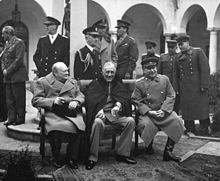
A photograph of Roosevelt, Stalin, and Churchill meeting in Yalta (Source: Wikimedia)
Stalin desired more. He wanted a ring of buffer states to protect him from a potentially resurgent Germany and other perceived threats. As a result, he demanded control over Poland, Finland, and the Baltic states. Roosevelt understood Stalin’s concerns, especially considering that the Soviets had done most of the fighting and had suffered the most losses. Stalin had promised free elections in Poland to appease Roosevelt. Churchill, meanwhile, had proposed that Stalin could have Yugoslavia if Britain could ensure that Greece remained democratic. The British hoped that if they had influence in Greece, they could ensure the safety of the Suez Canal.
As negotiations continued, Roosevelt died, and his Vice-President Harry Truman became President. Unlike Roosevelt, Truman did not have a good relationship with Stalin. Roosevelt never discussed the postwar proposals with Truman; he only spoke with his inner circle of advisors. When the Allied leaders met again at Potsdam (a suburb of Berlin) in the summer of 1945, Truman was less conciliatory than his predecessor had been. He thought Stalin was a butcher and a thug and made no secret of it.
Soon, the American foreign-policy establishment began to show signs of strain in its relations with the Soviets. In February 1946, George Kennan, America’s best foreign-policy expert on the Soviet Union, sent an exceedingly long telegram to the Treasury Department. In it, he offered a clear and concise understanding of Soviet foreign policy. The telegram proved very influential; it went to foreign-policy makers and was widely circulated throughout the government in 1946.
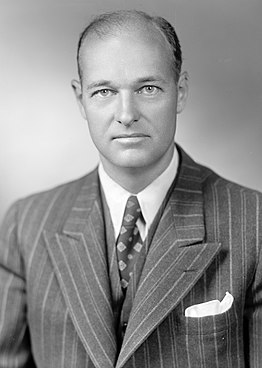
A photograph of George Kennan in 1947 (Source: Wikimedia)
Two things, Kennan argued, motivated Soviet power: traditional Marxist-Leninist ideology (as opposed to capitalism, free markets, and democracy) and security concerns. It was therefore safe to conclude that the goals of the Soviet Union were territorial expansion and the destruction of capitalism and democracy. The United States needed to confront this threat by the application of political and economic force to defend the core areas of Europe and Asia (Western Europe, Japan, and Manchuria). This marked the birth of the “containment doctrine,” which held that if the United States responded politically and economically to halt the Soviets’ gains, it would be able to contain them. Communism, according to the doctrine, would fail from its own weaknesses. This set out a new path for American foreign policy; the United States would now intervene in any country where communists threatened to take power. Kennan’s analysis promoted this “us versus them” mentality.
|
|
IN THEIR OWN WORDS |
|
George Kennan’s “Long Telegram” is a critically important document in Cold War history. In the following excerpt, Kennan argues that the Soviets cannot be trusted and will always work to undermine Western nations and especially the United States: Russians will participate officially in international organizations where they see opportunity of extending Soviet power or of inhibiting or diluting power of others. Moscow sees in UNO [United Nations Organization] not the mechanism for a permanent and stable world society founded on mutual interest and aims of all, but an arena in which aims just mentioned can be favorably pursued… Toward colonial areas and backward or dependent peoples, Soviet policy, even on official plane, will be directed toward weakening of power and influence and contacts of advanced Western nations, on theory that insofar as this policy is successful, there will be created a vacuum which will favor Communist-Soviet penetration. … Russians will strive energetically to develop Soviet representation in, and official ties with, countries in which they sense strong possibilities of opposition to Western centers of power. … In summary, we have here a political force committed fanatically to the belief that with US there can be no permanent modus vivendi, that it is desirable and necessary that the internal harmony of our society be disrupted, our traditional way of life be destroyed, the international authority of our state be broken, if Soviet power is to be secure. You can read a longer excerpt of the Telegram here. |
|
In the meantime, the Soviet Union was attempting to persuade the countries of Eastern Europe to establish friendly communist regimes. The Soviets could not control the countries directly with their own troops and govern the countries themselves, but they established Communist control through local communists who were supported by the remnants of Soviet troops who had been left behind.

Eastern Bloc Area Border Changes from 1938 to 1948 (Source: Wikimedia)
The Soviets followed a similar procedure in each case. Upon freeing the country from Nazi rule, they installed a “popular democracy.” At first, the country would have a coalition government with all parties represented. After a year, another coalition led by local Communists leaders would replace the first. The other parties were still included, but they were dominated by the Communists. This devious move usually went against the voters’ wishes. The Communists were generally somewhat popular, because in most cases they had led the resistance against the Nazis. Nonetheless, the people of Eastern Europe feared (correctly) that the Communists were agents of the Russian government. Only in Yugoslavia, where the Communist leader, Josip Broz (known simply as “Tito”), was well respected, did the Communists gain power because of widespread popular support.
The Eastern European Communists then pursued a program of social change. The economies in these countries were in terrible condition because of the Depression and the war, and the Communists sought to win popular support by addressing these problems. They nationalized key industries, beginning with those that Germans had owned previously. They also carried out agrarian reform. In Hungary, for example, 1% of the population owned 50% of the land before the Second World War. The government nationalized the land and redistributed it to the peasants.
The Communists were generally able to repair the economy, and in most cases even initiated economic growth. They never enjoyed overwhelming popular support, however. Although each country enjoyed a degree of national autonomy, they still lived under the threat of Soviet intervention. This helped Communist governments survive but at a cost. As a result, they became increasingly unpopular as Eastern Europeans were soon forced to sell goods to the Soviet Union at prices below world markets and pay artificially inflated prices for Soviet goods.
The Berlin Airlift
In the first years of the Cold War, Germany was center stage. The country had been divided into four zones of occupation, as had the capital, Berlin, which was otherwise far on the eastern side. In each case, the Soviet Union controlled the eastern half. The western half was divided between the United States, Great Britain, and France. The Soviets had initially agreed to permit supplies to enter Berlin from West Germany along a guarded highway on which there were no exits. As relations between the Soviets and the Western Allies worsened, however, the Soviets began to harass traffic travelling along this highway.
Finally, on June 24, 1948, the Soviets cut off all land traffic from West Germany into West Berlin. The city was quickly becoming a symbol of resistance to Soviet rule, and they hoped to starve it into submission. The Western Allies (the U.S., Britain, and France) needed to decide to either allow the city to fall to the Soviet Union or to protect it, possibly causing another war. Public opinion favored taking a stand, but the western governments were not ready to go to war.
Eventually, the Allies decided to create an “air bridge.” They eventually made 200,000 flights and carried 1.5 million tons of goods to keep West Berlin functioning. The Soviets could have tried to shoot the planes down, but they were not ready to go to war either. Finally, in May 1949, the Soviets lifted the blockade and the highway to Berlin reopened.
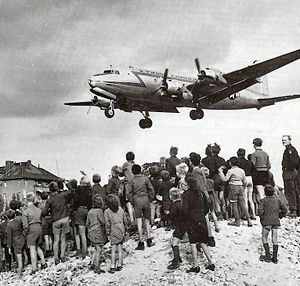
A photograph shows West Berliners waiting for a cargo plane to land with food and supplies in 1948 (Source: Wikimedia)
Changing of the Guard
Truman’s presidency ended in 1952. His successor, General Dwight D. Eisenhower, was a decorated war hero who had led the assault on Normandy Beach. Under Eisenhower, the nation’s Cold War policy remained essentially unchanged. An underlying focus on the containment of Soviet communism remained to inform the broad approach of U.S. foreign policy.
While the transition from the Truman to the Eisenhower presidencies was a conservative-moderate in character, the change in the Soviet Union was immense. With the death of Joseph Stalin (who led the Soviet Union from 1928 and through the Great Patriotic War) in 1953, his former right-hand man Nikita Khrushchev was named First Secretary of the Communist Party.
During a subsequent period of collective leadership, Khrushchev gradually consolidated his power. At a speech to the closed session of the Twentieth Party Congress of the Communist Party of the Soviet Union, February 25, 1956, Nikita Khrushchev shocked his listeners by denouncing Stalin’s personality cult and the many crimes that occurred under Stalin’s leadership. Although the contents of the speech were secret, it was leaked to outsiders, shocking both Soviet allies and Western observers. Khrushchev was later named premier of the Soviet Union in 1958.

A photograph of Nikita Khrushchev in 1963 (Source: Wikimedia)
|
|
IN THEIR OWN WORDS |
|
In his “Secret Speech,” Nikita Khrushchev renounced the corruption and violence of the Stalin era in the following words: We have to consider seriously and analyze correctly [the crimes of the Stalin era] in order that we may preclude any possibility of a repetition in any form whatever of what took place during the life of Stalin, who absolutely did not tolerate collegiality in leadership and in work, and who practiced brutal violence, not only toward everything which opposed him, but also toward that which seemed to his capricious and despotic character, contrary to his concepts. Stalin acted not through persuasion, explanation, and patient cooperation with people, but by imposing his concepts and demanding absolute submission to his opinion. Whoever opposed this concept or tried to prove his viewpoint, and the correctness of his position, was doomed to removal from the leading collective and to subsequent moral and physical annihilation… Stalin originated the concept enemy of the people. This term automatically rendered it unnecessary that the ideological errors of a man or men engaged in a controversy be proven; this term made possible the usage of the most cruel repression, violating all norms of revolutionary legality, against anyone who in any way disagreed with Stalin, against those who were only suspected of hostile intent, against those who had bad reputations. This concept, enemy of the people, actually eliminated the possibility of any kind of ideological fight or the making of one’s views known on this or that issue, even those of a practical character…. The only proof of guilt used, against all norms of current legal science, was the confession of the accused himself; and, as subsequent probing proved, confessions were acquired through physical pressures against the accused. This led to the glaring violations of revolutionary legality, and to the fact that many entirely innocent persons, who in the past had defended the Party line, became victims…. You can read a longer excerpt of the Speech here. |
|
The impact on Soviet politics was immense. The speech stripped Khrushchev’s remaining Stalinist rivals of their legitimacy in a single stroke, dramatically boosting the First Party Secretary’s power domestically. Khrushchev was then able to ease restrictions, freeing some dissidents and initiating economic policies that emphasized commercial goods rather than just coal and steel production.
Emergence of a Nuclear Strategy
An important part of the Cold War nuclear competition was the concept of mutual assured destruction (MAD). Mutual assured destruction or mutually assured destruction is a doctrine of military strategy and national security policy in which full-scale use of nuclear weapons by two or more opposing sides would cause the complete annihilation of both the attacker and the defender. It is based on the theory of deterrence, which holds that the threat of using strong weapons against the enemy prevents the enemy’s use of those same weapons.
When Eisenhower entered office in 1953, he was committed to two possibly contradictory goals: maintaining — or even heightening — the national commitment to counter the spread of Soviet influence and satisfying demands to balance the budget, lower taxes, and curb inflation. The most prominent of the doctrines to emerge from this goal was “massive retaliation,” which Secretary of State John Foster Dulles announced early in 1954. This new national security policy approach, reflecting Eisenhower’s concern for balancing the Cold War military commitments of the United States with the nation’s financial resources, was called the “New Look.” The policy emphasized reliance on strategic nuclear weapons to deter potential threats, both conventional and nuclear, from communist nations headed by the Soviet Union. Thus, the administration increased the number of nuclear warheads from 1,000 in 1953 to 18,000 by early 1961. Despite overwhelming U.S. superiority, one additional nuclear weapon was produced each day. The administration also exploited new technology. In 1955 the eight-engine B-52 Stratofortress bomber, the first true jet bomber designed to carry nuclear weapons, was developed.
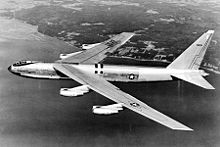
A side view of a B-52 Stratofortress bomber (Source: Wikimedia)
In 1960 and 1961, Khrushchev tried to impose the concept of nuclear deterrence on the military. Nuclear deterrence holds that the reason for having nuclear weapons is to discourage their use by a potential enemy. With each side deterred from war because of the threat of its escalation into a nuclear conflict, Khrushchev believed, “peaceful coexistence” with capitalism would become permanent and allow the inherent superiority of socialism to emerge in economic and cultural competition with the West. Like Eisenhower, Khrushchev hoped that exclusive reliance on the nuclear firepower of the newly created Strategic Rocket Forces would remove the need for increased defense expenditures. He also sought to use nuclear deterrence to justify his massive troop cuts and his plans to replace bombers with missiles and the surface fleet with nuclear missile submarines.
While the Soviets acquired atomic weapons in 1949, it took years for them to reach parity with the United States. In the meantime, the Americans developed the hydrogen bomb, which the Soviets matched during the era of Khrushchev. New methods of delivery such as Submarine-launched ballistic missiles and Intercontinental ballistic missiles with MIRV warheads meant that each superpower could easily devastate the other, even after an attack by an enemy.
The Space Race
One of the most important forms of non-violent competition between the U.S. and the USSR during the Cold War was the Space Race, with the Soviets taking an early lead in 1957 with the launching of Sputnik, the first artificial satellite, followed by the first manned flight.
|
Watch and Learn |
|
Watch the first report of Sputnik in a 1957 newsreel produced by Universal Studios.
|
The Space Race was a 20th-century competition between the Soviet Union and the United States for supremacy in space flight capability. It had its origins in the missile-based nuclear arms race between the two nations following World War II. The technological superiority required for such supremacy was perceived as necessary for national security and symbolic of ideological superiority. The Space Race spawned pioneering efforts to launch artificial satellites, unmanned space probes of the Moon, Venus, and Mars, and human space flight in low Earth orbit and to the Moon.
The competition began on August 2, 1955, when the Soviet Union responded to the US announcement four days earlier of intent to launch artificial satellites for the International Geophysical Year by declaring they would also launch a satellite “in the near future.” The Soviet Union beat the U.S. to this with the October 4, 1957, orbiting of Sputnik 1, and later beat the U.S. to the first human in space, Yuri Gagarin, on April 12, 1961. The race peaked with the July 20, 1969, U.S. landing of the first humans on the Moon with Apollo 11. The USSR tried but failed manned lunar missions, and eventually cancelled them and concentrated on Earth orbital space stations.
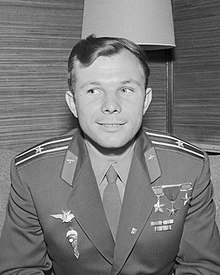
A photograph of Yuri Gagarin in 1961 (Source: Wikimedia)
A period of détente followed with the April 1972 agreement on a cooperative Apollo–Soyuz Test Project, resulting in the July 1975 rendezvous in Earth orbit of a U.S. astronaut crew with a Soviet cosmonaut crew. The end of the Space Race is harder to pinpoint than its beginning, but it was over by the December 1991 dissolution of the Soviet Union, after which true space flight cooperation between the U.S. and Russia began.
Influence Abroad
The United States and the Soviet Union increasingly competed for influence by proxy in the Third World as decolonization gained momentum in the 1950s and early 1960s.
The Eisenhower administration adjusted U.S. policy to the impact of decolonization, shifting the focus away from war-torn Europe. The combined effects of World War I and World War II had weakened the political and economic domination of Latin America, Asia, Africa, and the Middle East by European powers. This led to a series of waves of African and Asian decolonization following the Second World War as a world dominated for more than a century by Western imperialist colonial powers was transformed into a world of emerging African, Middle Eastern, and Asian nations.
The Cold War placed immense pressure on developing nations to align with one of the superpower factions. Both promised substantial financial, military, and diplomatic aid in exchange for an alliance, in which issues like corruption and human rights abuses were overlooked or ignored. When an allied government was threatened, the superpowers were often prepared and willing to intervene.
In such an international setting, the Soviet Union propagated a role as the leader of the “anti-imperialist” camp, currying favor in the Third World as being a stauncher opponent of colonialism. Khrushchev broadened Moscow’s policy by establishing new relations with India and other key non-aligned, non-communist states throughout the Third World. Many countries in the emerging non-aligned movement developed a close relation with Moscow.
The United States acted to curb the impact of Soviet intervention as it used the newly formed Central Intelligence Agency (CIA) to overthrow unfriendly governments. In the 1950s, the Eisenhower administration also attempted to formalize its alliance system through a series of pacts. Its East Asian allies were joined into the Southeast Asia Treaty Organization (SEATO) while friends in Latin America were placed in the Organization of American States. The ANZUS alliance was signed between the Australia, New Zealand, and the US. None of these groupings was as successful as NATO had been in Europe.
Many newly independent nations, however, did not want to align themselves with either of the superpowers. The non-aligned movement, led by India, Egypt, and Austria, attempted to unite against what was perceived as continued imperialism by both the East and the West.
|
Watch and Learn |
|
Watch this video produced by the Khan Academy to learn more about the pattern of US Cold War Interventions.
|
Latin America
The Eisenhower approach to foreign policy sought to overthrow unfriendly governments in a covert way. Throughout much of Latin America, reactionary oligarchies ruled through their alliances with the military elite and United States. Although the nature of the U.S. role in the region was established many years before the Cold War, the Cold War gave U.S. interventionism a new ideological tinge. By the mid-20th century, much of the region passed through a higher state of economic development, which bolstered the power and ranks of the lower classes. This made calls for social change and political inclusion more pronounced, posing a challenge to the strong U.S. influence over the region’s economies. By the 1960s, Marxists, who opposed the concentration of wealth in the hands of a few wealthy elite and proposed the distribution of wealth equally to all members of society, gained increasing influence throughout the regions, prompting fears in the United States that Latin American instability posed a threat to U.S. national security.
Throughout the Cold War years, the U.S. acted to stop socialist revolutions by targeting populist and nationalist governments throughout Latin America. The CIA overthrew governments suspected of turning pro-communist. For example, the CIA Operation PBSUCCESS planned and executed a 1954 coup that removed democratically elected Jacobo Arbenz from power in Guatemala. Arbenz, who was supported by some local communists, was ousted shortly after he had redistributed 178,000 acres of United Fruit Company land in Guatemala. United Fruit had long monopolized the transportation and communications region there along with the main export commodities and played a major role in Guatemalan politics. Arbenz was out shortly afterwards, and Guatemala came under control of a repressive military regime supported by the United States.
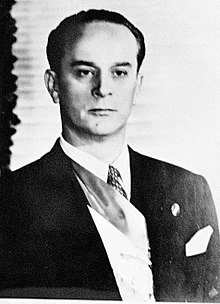
A photograph of Jacobo Arbenz, who was the 25th democratically elected President of Guatemala (Source: Wikimedia)
Future Latin American revolutionaries shifted to guerrilla tactics, particularly following the Cuban Revolution. Arbenz fell when his military had deserted him. Since then, Latin American social revolutionaries and Marxists, most notably Fidel Castro and the Sandinistas in Nicaragua, made the army and governments parts of a single unit and eventually set up single-party states.
Africa
One of the first decolonized nations to request Soviet aid was the Democratic Republic of the Congo under Patrice Lumumba. Many United Nations peacekeepers from NATO nations and other NATO allies had been in the Congo since independence was established from Belgium in 1960. The U.S. used them to shut down air traffic and prevent Soviet arms and troops from getting into the country. However, some Soviet weapons managed to get in from other countries. The “peacekeepers” decided to remove Lumumba and backed Colonel Joseph Mobutu in a coup in which Lumumba was killed. The Congolese crisis had the effect of alienating from both Euro-Americans and the Soviets as some in the third world saw the Soviets as weak and impotent and Euro-Americans as unethical and unscrupulous.
Middle East
In 1953, President Eisenhower’s CIA implemented Operation Ajax, a covert operation aimed at the overthrow of the Iranian prime minister, Mohammad Mosaddegh. Time Magazine had declared him to be the “man of the year” because of his commitment to democracy in Iran. However, the popularly elected and non-aligned Mosaddegh had been a Middle Eastern nemesis of Britain since nationalizing the British-owned Anglo-Iranian Oil Company in 1951. Winston Churchill told the United States that Mosaddegh was “increasingly turning towards communism.” With the active assistance of the CIA, he was overthrown by forces supporting the pro-Western shah, Mohammad Reza Pahlavi. Pahlavi assumed control after the operation as an autocratic monarch. The Shah’s policies included banning the communist Tudeh Party and general suppression of political dissent by SAVAK, the shah’s domestic security and intelligence agency.
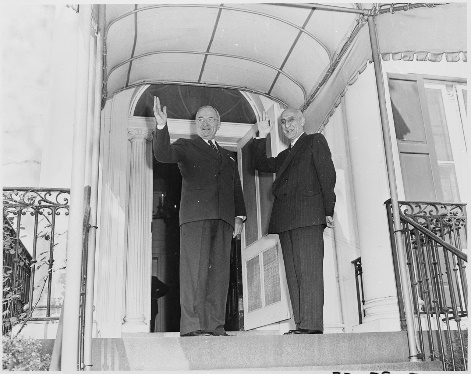
Shortly after he was elected, Mosaddegh visited with President Truman in the White House. This photograph was taken after their meeting. (Source: Wikimedia)
The 1956 Suez Crisis
The Middle East during the Cold War was of extreme importance and also great instability. The region lay directly south of the Soviet Union, which traditionally had great influence in Turkey and Iran. The area also had vast reserves of oil, not crucial for either superpower in the 1950s (which each held large oil reserves on its own), but essential for the rapidly rebuilding American allies Europe and Japan.
The Suez Crisis, also named the Tripartite Aggression and the Kadesh Operation, was an invasion of Egypt in late 1956 by Israel, followed by the Great Britain and France. The aims were to regain British-French control of the Suez Canal and remove Egyptian President Gamal Abdel Nasser from power who had nationalized the Canal.
On October 29, Israel invaded the Egyptian Sinai. Britain and France issued a joint ultimatum to cease fire, which was ignored. On November 5, Britain and France landed paratroopers along the Suez Canal. The Egyptian forces were defeated but did block the canal to all shipping. It became clear that the Israeli invasion and the subsequent Anglo-French attack were planned beforehand by the three countries. The three allies attained a number of their military objectives, but the Canal was now useless and heavy pressure from the United States and the USSR forced them to withdraw. As a result of the conflict, the United Nations created the UNEF Peacekeepers to police the Egyptian-Israeli border.
The Suez stalemate was a turning point heralding an ever-growing rift between the Atlantic Cold War allies, which were becoming far less of a united monolith than they were in the immediate aftermath of the Second World War. Italy, France, Spain, West Germany, Norway, Canada, and Britain also developed their own nuclear forces as well as a Common Market to be less dependent on the United States. Such rifts mirror changes in global economics. American economic competitiveness faltered in the face of the challenges of Japan and West Germany, which recovered rapidly from the wartime decimation of their respective industrial bases. The 20th-century successor to the UK as the “workshop of the world,” the United States found its competitive edge dulled in the international markets while it faced intensified foreign competition at home. Meanwhile, the countries aligned with the Soviet Union in the Warsaw Pact were closely connected both militarily and economically. All Warsaw Pact nations had nuclear weapons and supplied other countries with weapons, supplies, and economic aid.
The Korean War
One of the most significant impacts of the U.S. policy of containment was the outbreak of the Korean War, when the U.S. came to aid of South Korea against the communist North Korea.
In June 1950, Kim Il-Sung’s North Korean People’s Army invaded South Korea. Fearing that communist Korea under a Kim Il-Sung dictatorship could threaten Japan and foster other communist movements in Asia, Truman committed U.S. forces and obtained help from the United Nations to counter the North Korean invasion. The Soviets boycotted UN Security Council meetings while protesting the Council’s failure to seat the People’s Republic of China and thus did not veto the Council’s approval of UN action to oppose the North Korean invasion. A joint UN force of personnel from South Korea, the United States, Britain, Turkey, Canada, Australia, France, the Philippines, the Netherlands, Belgium, New Zealand, and other countries joined to stop the invasion.
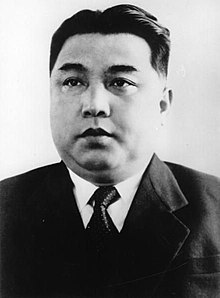
An official photograph of King Il-Sung (Source: Wikimedia)
After the first two months of the conflict, South Korean forces were on the point of defeat, forced back to the Pusan Perimeter. In September 1950, an amphibious UN counter-offensive was launched at Inchon and cut off many of the North Korean troops. Those that escaped envelopment and capture were rapidly forced back north all the way to the border with China at the Yalu River or into the mountainous interior. At this point, in October 1950, Chinese forces crossed the Yalu and entered the war. Chinese intervention triggered a retreat of UN forces that continued until mid-1951.
After these reversals of fortune, which saw Seoul change hands four times, the last two years of conflict became a war of attrition, with the front line close to the 38th parallel. The war in the air, however, was never a stalemate. North Korea was subject to a massive bombing campaign. Jet fighters confronted each other in air-to-air combat for the first time in history, and Soviet pilots covertly flew in defense of their communist allies.
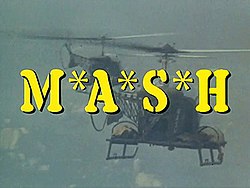
One of the most popular television comedies of the 1970s in the United States, Mash, depicted a field hospital in Korea during the Korean War (Source: Wikimedia)
The fighting ended on July 27, 1953, when an armistice was signed. The agreement created the Korean Demilitarized Zone to separate North and South Korea and allowed the return of prisoners. In North Korea, Kim Il-sung created a highly centralized and brutal dictatorship, according himself unlimited power and generating a formidable cult of personality. However, no peace treaty has been signed, and the two Koreas are technically still at war. Periodic clashes, many of which are deadly, have continued to the present.
The Korean War is seen as one of the most significant impacts of the containment policy of the U.S. government, aimed at preventing the spread of communism, and was one of the major proxy wars of the Cold War. Among other effects, the Korean War galvanized NATO to develop a military structure. Public opinion in countries involved, such as Great Britain, was divided for and against the war. Many feared an escalation into a general war with Communist China and even nuclear war. The strong opposition to the war often strained Anglo-American relations.
The war was initially a political disaster for the Soviet Union. Its central objective, the unification of the Korean peninsula under the Kim Il-Sung regime, was not achieved. Boundaries of both parts of Korea remained practically unchanged. Relations with communist ally China were seriously and permanently spoiled, leading to the Sino-Soviet split that lasted until the collapse of the Soviet Union in 1991. On the other hand, because of the war, the prestige of the Soviets grew in the new nations which were forming. Because the Soviet Union had been willing to help the North Koreans in their struggle against imperialists, many of the new nations formed after the Korean War looked to the Soviet Union for protection and aid.
The war, meanwhile, united the countries within the capitalist bloc: the Korean War accelerated the conclusion of a peace agreement between the U.S. and Japan, the warming of West Germany’s relations with other western countries, and creation of military and political blocs.
The Vietnam War
The military conflict in Vietnam in the 1960s, was, in fact, as much about colonialism and imperialism as it was communism: the essential motivation of the North Vietnamese forces was to seize genuine independence from foreign powers. The war itself was an outgrowth of the conflict between the Vietnamese and their French colonial masters, one that eventually dragged in the United States.
The war “really” began with the end of World War II. During the war, the Japanese seized Vietnam from the French, but with the Japanese defeat the French tried to reassert control, putting a puppet emperor on the throne and moving their forces back into the country. Vietnamese independence leaders, principally Ho Chi Minh, led the communist North Vietnamese forces (the Viet Minh) in a vicious guerrilla war against the French forces and their South Vietnamese allies. The Soviet Union and China both provided weapons and aid to the North Vietnamese, while the US anticipated its own (later) invasion by supporting the South.
The French period of the conflict reached its culminating point in 1954 when the French were soundly defeated at Dien Bien Phu, a French fortress that was overwhelmed by the Viet Minh. The French retreated, leaving Vietnam split between the communists in the north and a corrupt but anti-communist force in the south supported by the United States. Refusing to allow the national elections that had been planned for 1956, the US instead propped up an unpopular president, Ngo Dinh Diem, who claimed authority over the entire country. An insurgency, labeled the Viet Cong (“Vietnamese communists”) by the Diem government, supported by the north erupted in 1958, leading the US to provision hundreds of millions of dollars in aid and, soon, an increasing number of military advisers to the south.
In 1964, pressured by both Soviet and Chinese advisers and with the US stepping up pressure on the Viet Cong, the Viet Minh leadership launched a full-scale invasion in the name of Vietnamese unification. American involvement skyrocketed as the South Vietnamese proved unable to contain the Viet Minh and the Viet Cong insurgents. Over time, thousands of American military “advisers,” mostly made up of what would become known as special forces, were joined by hundreds of thousands of American troops. In 1964, citing a fabricated attack on an American ship in the Gulf of Tonkin, President Lyndon Johnson called for a full-scale armed response, which opened the floodgates for a true commitment to the war (technically, war was never declared, however, with the entire conflict constituting a “police action” from the American policy perspective).
American and South Vietnamese forces were fought to a standstill by the Viet Minh and Viet Cong, with neither side winning a definitive victory. All the while, however, the war was becoming more and more unpopular in America itself and in its allied countries. As the years went by, journalists catalogued much of the horrific carnage unleashed by American forces, with jungles leveled by chemical agents and napalm and, notoriously, civilians massacred. The United States resorted to a lottery system tied to conscription – “the draft” – in 1969, which led to tens of thousands of American soldiers sent against their will to fight in jungles thousands of miles from home. Despite the vast military commitment, US and South Korean forces started to lose ground by 1970.
In 1973, with American approval for the war hovering at 30%, President Richard Nixon oversaw the withdrawal of American troops and the end of support for the South Vietnamese. The Viet Minh finally seized the capital of Saigon and ended the war in 1975. The human cost was immense: over a million Vietnamese died, along with some 60,000 American troops.
The Berlin Wall
The Berlin Wall was a barrier that divided Germany from 1961 to 1989. Constructed by the German Democratic Republic (GDR, East Germany) starting on August 13, 1961, the Wall completely cut off West Berlin from surrounding East Germany and from East Berlin until government officials opened it in November 1989. Its demolition officially began on June 13, 1990 and was completed in 1992. The barrier included guard towers placed along large concrete walls, which circumscribed a wide area (later known as the “death strip”) that contained anti-vehicle trenches, “fakir beds,” and other defenses. The East Germans claimed that the Wall was erected to protect its population from fascist elements conspiring to prevent the “will of the people” in building a socialist state in East Germany. In practice, the Wall prevented the massive emigration and defection that had marked East Germany and the communist Eastern Bloc during the post-World War II period.
The Berlin Wall was officially referred to as the “Anti-Fascist Protective Wall” by GDR authorities, implying that the NATO countries and West Germany in particular were considered “fascists” by GDR propaganda. The West Berlin city government sometimes referred to it as the “Wall of Shame”—a term coined by mayor Willy Brandt—while condemning the Wall’s restriction on freedom of movement. Along with the separate and much longer Inner German border (IGB), which demarcated the border between East and West Germany, it came to symbolize a physical marker of the “Iron Curtain” that separated Western Europe and Communist nations during the Cold War.
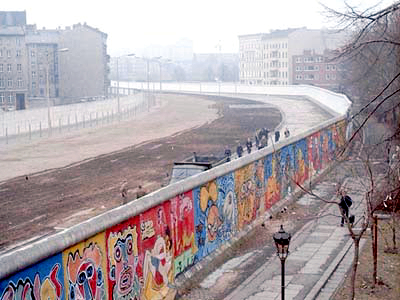
A photograph of the Berlin Wall (from West Berlin) in 1986 (Source: Wikimedia)
With the closing of the East-West sector boundary in Berlin, most East Germans could no longer travel or emigrate to West Germany. Berlin soon went from the easiest place to make an unauthorized crossing between East and West Germany to the most difficult. Many families were split, and East Berliners employed in the West were cut off from their jobs. West Berlin became an isolated exclave in a hostile land. The construction of the Wall caused considerable hardship to families divided by it. Most people believed that the Wall was mainly a means of preventing the citizens of East Germany from entering or fleeing to West Berlin.
During the years of the Wall, around 5,000 people successfully defected to West Berlin. The number of people who died trying to cross the Wall or as a result of the Wall’s existence has been disputed. The East German government issued shooting orders to border guards dealing with defectors. Early successful escapes involved people jumping the initial barbed wire or leaping out of apartment windows along the line, but these ended as the Wall was fortified. East Germans successfully defected by a variety of methods: digging long tunnels under the Wall, waiting for favorable winds and taking a hot air balloon, sliding along aerial wires, flying ultralights and, in one instance, simply driving a sports car at full speed through the basic initial fortifications.
|
Watch and Learn |
|
In a famous speech at the Berlin Wall in 1987, President Ronald Reagan challenged the Soviet leader, Mikhail Gorbachev, to “tear down this wall.” Watch the full speech here. The famous challenge can be viewed at 11:10 in the video.
|
The Cuban Missile Crisis
The Cuban Missile Crisis was a 13-day (October 16-28, 1962) confrontation between the United States and the Soviet Union concerning American ballistic missile deployment in Italy and Turkey with consequent Soviet ballistic missile deployment in Cuba. Televised worldwide, this event was the closest the Cold War came to a full-scale nuclear war.
In response to a failed attempt by the United States to overthrow Fidel Castro, the communist leader of Cuba, and the presence of American Jupiter ballistic missiles in territory close to the Soviet Union (especially Turkey), Soviet leader Nikita Khrushchev agreed to Castro’s request to place nuclear missiles in Cuba to deter future harassment by the United States. An agreement was reached during a secret meeting between Khrushchev and Fidel Castro in July 1962 and construction of a number of missile launch facilities started later that summer.
In response, the United States established a military blockade to prevent further missiles from entering Cuba. It announced that they would not permit offensive weapons to be delivered to Cuba and demanded that the weapons already in Cuba be dismantled and returned to the USSR. After a long period of tense negotiations, an agreement was reached between President John F. Kennedy and Khrushchev on October 27. Publicly, the Soviets would dismantle their offensive weapons in Cuba and return them to the Soviet Union, subject to United Nations verification, in exchange for a U.S. public declaration and agreement never to invade Cuba without direct provocation. Secretly, the United States agreed that it would dismantle all U.S.-built Jupiter MRBMs, which were deployed in Turkey against the Soviet Union.
When all offensive missiles and Ilyushin Il-28 light bombers were withdrawn from Cuba, the blockade was formally ended on November 20, 1962. The negotiations between the United States and the Soviet Union pointed out the necessity of a quick, clear, and direct communication line between Washington and Moscow. As a result, the Moscow–Washington hotline was established. A series of agreements sharply reduced U.S.–Soviet tensions during the following years.
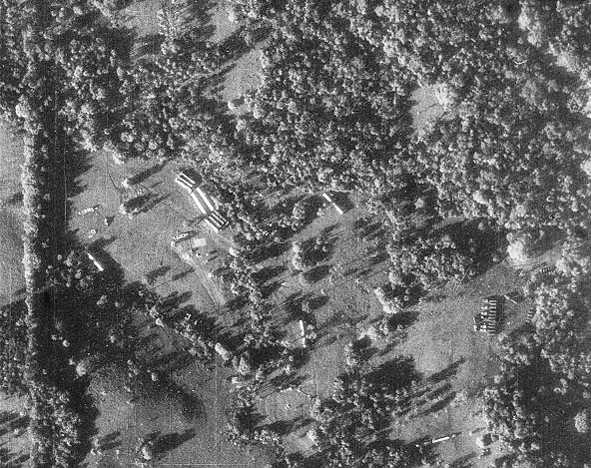
A photograph taken by the United States Air Force of the ballistic missile sites in Cuba (Source: Wikimedia)
The compromise embarrassed Khrushchev and the Soviet Union because the withdrawal of U.S. missiles from Italy and Turkey was a secret deal between Kennedy and Khrushchev. Khrushchev went to Kennedy thinking that the crisis was getting out of hand. The Soviets were seen as retreating from circumstances they had started. Khrushchev’s fall from power two years later was in part because of the Politburo embarrassment at both Khrushchev’s eventual concessions to the U.S. and his ineptitude in precipitating the crisis in the first place.
|
Before reading the next section — Watch and Learn |
|
Watch the following videos to learn more about the history of the Soviet Union:
|
